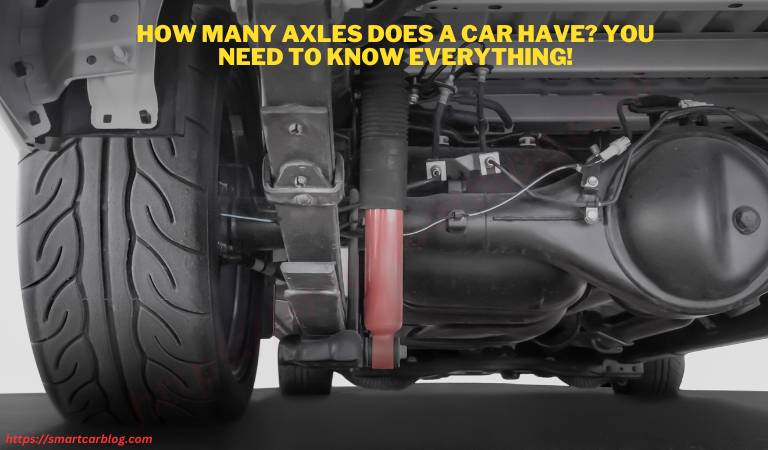Summaries
- The article addresses the fundamental question, “How many axles does a car have?” highlighting the crucial role of axles in vehicle design and function.
- The article explores the history of car axles, from their simple origins connecting wheels to vehicles to the advanced designs driven by technological advancements.
- Differentiating between front axles, rear axles, and inter-axle systems, the article delves into the specific functions of each type in modern vehicles.
- The article explores the core functions of axles beyond their structural role, including their impact on vehicle dynamics, performance, handling, stability, and power transmission.
- Axle maintenance is presented as essential for vehicle longevity and safety, emphasising the need for routine inspections, lubrication, and alignment checks.
- Advanced materials like carbon fiber composites and high-strength steel are introduced as innovations in modern axle manufacturing, enhancing strength while reducing weight.
When discussing the fundamental components of a vehicle, a common inquiry is “How many axles does a car have?” This question highlights the significance of axles in automotive design and function. Axles are crucial elements in any vehicle, affecting various aspects like performance, safety, and the overall driving experience.
In this article, we will explore what car axles are, their critical role in vehicle mechanics, and their evolution through the years. Whether you’re a car enthusiast or simply curious about the mechanics of vehicles, this introduction aims to enrich your understanding of car axles.
Table of Contents
ToggleImportance of Axles in Cars
Axles are the foundation of a car’s motion and go beyond simple structural components. They provide stability and balance when driving by carrying the entire weight of the automobile, including the passengers and cargo. The handling and ride quality are also affected by the axles.
The performance and safety of the vehicle are directly impacted by the axles’ design and state. Any automobile owner must perform routine maintenance on their axle and be aware of its condition. This emphasises the significance of knowing concepts such as “how many axles does a car have” and their operational state.
Brief History of Car Axle Development
The history of car axles is as old as the automobile itself. Initially, axles in cars were simple and straightforward, serving the primary function of connecting wheels to the vehicle. As automotive technology advanced, so did axle design and functionality.
Early automobiles featured basic, rigid axles, but the advent of independent suspension systems revolutionized this component. This progression led to enhanced vehicle handling, safety, and comfort, underscoring the axle’s pivotal role in the evolution of automotive design and technology.
Basic Concepts of Car Axles
A fundamental knowledge of automobile axles is necessary for anyone interested in automotive repair or attempting to answer queries such as “How many axles does a car have?” The handling, safety, and performance of any vehicle are greatly influenced by its axles. This page explains the definition of an axle, the several types of axles used in modern cars, and their features and purposes.
What is an Axle?
An axle, which is just a rod or shaft with several uses, is a crucial part of an automobile’s wheel system. Simply said, it aids in accurately aligning and balancing the wheels and securing them in place. However, an axle’s function goes beyond simple placement.
It is an essential component of the vehicle’s steering system, helps drive axles transfer power from the engine to the wheels, and contributes to the braking system. Understanding “how many axles are in a car” or “how many axles does my car have” is essential to knowing how to properly repair and run your car.
Types of Axles in Modern Vehicles
Different axle types, each intended for a particular purpose and vehicle type, are found on modern automobiles. Front axles, rear axles, and inter-axle systems are the three primary groups; each has special traits and functions.
Front Axles
The front axles are in the front of the car and are in charge of helping with steering and cushioning impact from the pavement. Because they are connected to the engine power transmission and steering system in front-wheel drive cars, they are usually more complicated than rear axles. The condition of the front axle is essential for handling and steering properly.
Rear Axles
The function of the rear axles, which are found in the rear of the car, is usually to transfer power to the driving wheels. They are essential to the propulsion of cars with rear-wheel drive. To manage the transferred torque and maintain stability, rear axles need to be strong and long-lasting.
Inter-Axle Systems
Large trucks and buses, for example, have more than two axles; these types of vehicles use inter-axle systems. These systems improve the vehicle’s stability and carrying capacity by dividing the weight and power among several axles. When working with heavy-duty vehicles or multi-axle setups, it is imperative to comprehend the complexities of inter-axle systems.
Must read: How Many Catalytic Converters Does A Car Have?
Must read: How Long Is a Car? You Need To Know Everything!
How Many Axles Does a Car Have?
The query “How many axles does a car have?” is among the most commonly posed in the field of automotive mechanics. This inquiry holds significant importance for both car proprietors and enthusiasts in relation to the design and functionality of the vehicle.
The number of axles influences the maneuverability, stability, and overall efficacy of a vehicle. The purpose of this article is to examine the variations in axle configuration among various car models and to clarify the standard axle count in passenger cars.
Standard Axle Count in Passenger Cars
Passenger vehicles are conventionally outfitted with two axles. This conventional arrangement comprises a front axle and a rear axle. In many vehicles, the front axle is also responsible for transferring engine force to the front wheels.
However, in rear-wheel-drive models, the rear axle may merely sustain the vehicle’s weight or be responsible for power delivery. A fundamental comprehension of the inquiry “How many axles does a car have?” is critical for acquiring knowledge regarding vehicle operation and maintenance.
Axle Variations in Different Car Models
While two axles are standard in most passenger cars, some variations exist, especially in specialized or high-performance vehicles. For instance, sports cars, all-terrain vehicles, or larger SUVs may feature different axle configurations for enhanced performance, stability, or load-bearing capacity.
Additionally, some luxury cars or electric vehicles (EVs) might employ unique axle structures to accommodate advanced drivetrains or battery placements. These variations highlight the diverse applications of axles in modern automotive design and the importance of knowing “how many axles are on a car” specific to the model and make of your vehicle.
Functionality and Mechanics of Car Axles
Understanding the functionality and mechanics of car axles is key to grasping how vehicles operate. A common question among car owners is “how many axles does a car have?” This query goes beyond a mere count; it delves into the significance of axles in a vehicle’s overall dynamics and performance.
In this section, we will explore the vital role of axles in vehicle mechanics, their impact on car performance, handling, stability, and their crucial role in power transmission.
Role of Axles in Vehicle Dynamics
Axles are essential parts of any vehicle’s construction. Although their purpose is far more intricate, they act as the wheel’s core shaft. The steering mechanism of an automobile relies heavily on its axles, which allow the wheels to turn and react to the driver’s inputs. They support the suspension and general stability of the car by bearing the weight of the vehicle as well.
Car owners and enthusiasts can better comprehend the nuances of “how many axles are in a car” and their effect on the driving experience by knowing the role that axles play in their vehicles.
How Axles Affect Car Performance
The performance of an automobile is directly impacted by the design and state of its axles. This covers features including the car’s efficiency, speed, and capacity to handle various types of terrain.
Impact on Handling and Stability
The way an automobile handles and stays stable is greatly influenced by its axles. A well-thought-out axle arrangement guarantees that the car can easily navigate twists and turns while keeping its stability and balance. Particularly at high speeds or in difficult driving circumstances, the way axles distribute weight throughout the car’s body is crucial for preventing rollovers and guaranteeing smooth functioning.
Axle’s Role in Power Transmission
A major purpose of an axle is to transfer power from the engine to the wheels, especially in cars with front- or rear-wheel drive. The movement and acceleration of the car depend on this mechanism. The design and state of the axle have a significant impact on the power transmission’s smoothness and efficiency.
Knowing “How many axles does my car have” might help you understand how power is distributed throughout the car and how drivable it is overall.
Special Types of Axles for Different Purposes
Although most cars can answer the basic question, “How many axles does a car have?” axle types and functions can differ significantly based on the intended use of the vehicle. This section explores the specific axles used in racing automobiles and off-road vehicles, emphasizing their special qualities and functions in these high-performance environments.
Axles in Off-Road Vehicles
Rugged terrain and difficult conditions are what off-road vehicles are made for. These vehicles’ axles offer increased strength and stability and are designed to endure harsh environments. With wider ground clearance and flexibility, they are usually more durable than regular car axles.
This design protects the undercarriage while allowing off-road vehicles to traverse rocky and uneven terrain. In off-road applications, “how many axles in a car” matters just as much as how effectively those axles can handle tough terrain. Hence, the durability and design of the axle are crucial.
Racing Car Axles and Their Unique Characteristics
Axles for racing automobiles need to be able to withstand fast speeds and rough terrain. These cars’ axles are designed for optimal performance, with a focus on quickness, agility, and accuracy.
In order to lower the vehicle’s overall weight and improve acceleration and top speed, they are frequently lighter than regular axles. In order to withstand the extreme stress and heat produced during races, racing car axles may also have unique materials and designs. An automobile’s ability to perform is greatly influenced by its axle arrangement.
Maintenance and Troubleshooting for Car Axles
Car axle maintenance and troubleshooting are essential to any vehicle’s longevity and safety. Common axle difficulties, including wear and tear, corrosion, and alignment problems, can be avoided with routine inspections and maintenance. Axle problems might be indicated by strange noises (clicking or groaning), vibrations during driving, or leaks around the axle area.
Car owners should be aware of these warning signals. Knowing the fundamentals of “how many axles does my car have?” is the first step in maintaining your axles. Next, you should study the particular maintenance and troubleshooting methods for each kind of axle.
Common Axle Problems and Solutions
Axle problems can vary, but some are more common than others. Issues such as axle wear, CV (Constant Velocity) joint failures, or lubrication leaks can lead to serious vehicle malfunctions. For example, if you hear clicking noises when turning, it might indicate a problem with the CV joints, which are crucial parts of the front axle in front-wheel-drive cars.
Regular inspection and timely replacement of worn-out parts are essential. Knowing “how many axles are in a car” helps in identifying where the problem might be and addressing it promptly.
Tips for Regular Axle Maintenance
Regular axle maintenance is key to preventing many common problems. This includes:
- Regular Inspections: Regularly checking the condition of your axles, including the CV joints and boots, can help catch issues early.
- Lubrication: Ensuring that your axles are properly lubricated is crucial for smooth operation and longevity.
- Alignment Checks: Misaligned axles can lead to uneven tire wear and handling issues. Regular alignment checks are necessary for maintaining axle health.
Understanding the basics of “how many axles does my car have?” and their specific maintenance needs can greatly extend the life of these components.
When to Seek Professional Help for Axle Issues
While most car owners can do basic axle maintenance, certain situations require professional assistance. If you experience persistent problems such as severe vibrations, difficulty in steering, or loud noises from the axle area despite regular maintenance, it’s time to consult a professional mechanic.
Complex issues like axle misalignment or CV joint damage often need specialised tools and expertise. In such cases, professional diagnosis and repair are crucial for ensuring your vehicle’s safety and performance.
Innovations and Future Trends in Car Axle Technology
Car axle technology advances in tandem with the automotive industry. Not only may innovations in this sector answer the question, “How many axles does a car have?” but they also address the manufacture and operation of these axles in contemporary vehicles.
This section highlights the emerging trends that are reshaping the automotive axle industry by going over the improvements in the materials used in axle manufacturing as well as the revolutionary effect of electric vehicles on axle design.
Advanced Materials in Axle Manufacturing
The quest for efficiency and performance in the automotive sector has led to significant advancements in axle manufacturing. Increasingly, sophisticated materials such as carbon fiber composites, high-strength steel, and aluminum are used to construct contemporary axles.
These materials provide an exceptional strength-to-weight ratio, which is crucial for decreasing the vehicle’s overall weight while maintaining its durability and performance. The use of advanced materials in axles enhances fuel efficiency, reduces emissions, and improves handling, indicating a significant leap in automotive axle technology.
The Impact of Electric Cars on Axle Design
The rise of electric vehicles (EVs) has brought a paradigm shift in axle design. Unlike traditional internal combustion engine vehicles, EVs have different powertrain architectures, which directly influence axle design and functionality. Electric cars often employ more compact and efficient axle systems, some even integrating the motor directly into the axle (known as e-axles), optimizing space and improving efficiency.
This integration not only simplifies the drivetrain by reducing the number of moving parts but also allows for better torque management and vehicle dynamics. The impact of electric cars on axle design is a testament to how technological advancements can redefine component functionality in the automotive industry.
Final Thought: How Many Axles Does a Car Have
In conclusion, the question “How many axles does a car have?” finds its answer in the standard design of most passenger vehicles, which typically feature two axles. However, as we have explored, the world of automotive design is rich and varied, with different vehicles boasting different axle configurations to suit their specific purposes. From the robust axles in off-road vehicles to the advanced and efficient designs in electric cars, the axle remains a fundamental component that adapts and evolves with automotive technology.
Whether it’s ensuring smooth performance, contributing to vehicle safety, or enhancing fuel efficiency, axles play an indispensable role in the mechanics of a car. As automotive technology continues to advance, the function and design of car axles will undoubtedly continue to innovate, reflecting the ever-changing landscape of vehicle engineering.
FAQ: How Many Axles Does a Car Have
Q: Does a car have 2 or 4 axles?
A: Most cars have two axles designed to support the engine, the body, and the passengers.
Q: How many axles does a 4-wheel drive have?
A: A 4-wheel drive vehicle typically has two axles, similar to most passenger cars.
Q: What vehicles have 3 or more axles?
A: Larger vehicles like buses, semi-trucks, and some RVs have three or more axles.
Q: What is 1 axle?
A: One axle refers to a single central shaft for rotating wheels or gears, found in most two-wheeled vehicles.
Q: Do normal cars have 2 axles?
A: Yes, normal cars usually have two axles.
Q: Does a car have 1 or 2 axles?
A: Cars typically have two axles.
Q: Does a car have 4 CV axles?
A: Standard cars have two CV (Constant Velocity) axles, one for each front wheel.
Q: What is 4X4 vs 4×2 axles?
A: 4×4 (four-wheel drive) vehicles distribute power to all four wheels, while 4×2 (two-wheel drive) send power to either the front or back two wheels.
Q: How many axles does a BMW have?
A: Most BMW cars, being standard passenger vehicles, have two axles.
Q: Can a car have one axle?
A: Cars typically have at least two axles; one-axle designs are more common in motorcycles and bicycles.
Q: How many axles does a car have in the world?
A: Globally, the standard design for cars includes two axles.
Q: How many axles does a car have brakes?
A: Brakes are present on all wheels of a car, which typically means two axles in a standard car.
Q: How many axles does a truck have?
A: Trucks vary in size and can have two to five axles, with larger trucks having more.
Q: What is an axle on a car?
A: An axle on a car is a central shaft for rotating wheels, crucial for the vehicle’s movement.
Q: What is the axle car price?
A: The cost of a car axle varies depending on the car model and type of axle.
Q: How many axles does an AWD car have?
A: All-wheel-drive (AWD) cars typically have two axles.
Q: How many axles does an SUV have?
A: Most SUVs have two axles, similar to standard passenger cars.
Q: Car axle replacement cost?
A: The cost to replace a car axle varies but can range from $500 to $950 on average.
Q: What do axles mean in a car?
A: In a car, axles are the central shafts that connect and rotate the wheels.
Q: How many CV axles are on a car?
A: There are typically two CV axles in a car, each connected to the front wheels.




 Welcome to SmartCarBlog.com! I’m Rashel Miajee, The proud founder of smartcarblog.com. This is a part of
Welcome to SmartCarBlog.com! I’m Rashel Miajee, The proud founder of smartcarblog.com. This is a part of 


